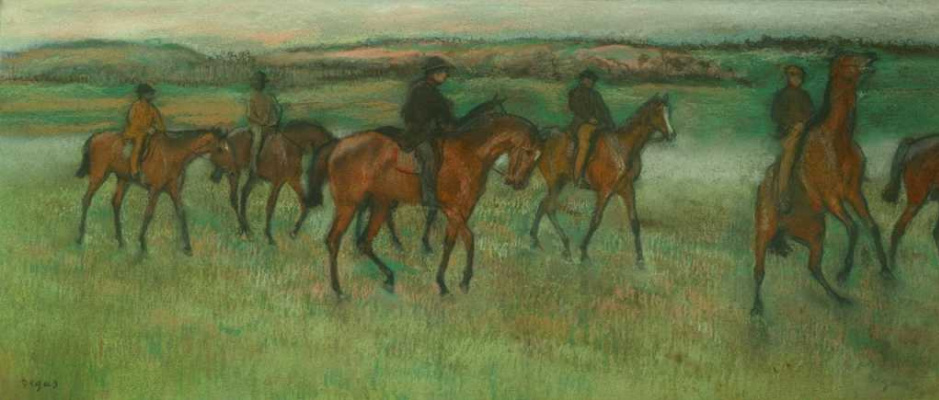log in
Enter site
Login to use Arthive functionality to the maximum
Exercising Racehorses
Edgar Degas • Painting, 1880, 36×86 cm
Description of the artwork «Exercising Racehorses»
In 1857, at the time of Baron Haussmann’s great renovation of Paris, the first racecourse was opened. It was located in the Bois de Boulogne, a favorite place for the Parisian nobility to go for walks to. Sailing and horseracing became French people’s most fashionable hobbies. Now they spent all their free time at the racecourse and on the river.
Degas admired horses, yet the jockeys he admired even more. In them, he saw the ultimate expression of his constant brain-twisting challenge — how to depict the elusive and awkward in-between moments that, in their succession, formed the rapidity of motion.
Degas started painting horses and jockeys in motion even before a legendary debate took place, one of the funniest and most significant in the history of art and cinema. Leland Stanford, a politician, train-and-ship-owner, and the founder of Stanford University, once had a bet with his friends. He claimed that there were moments when a horse had all four feet off the ground while trotting. His opponents disagreed saying that one leg always remained in contact with the ground. Stanford commissioned the photographer Eadweard Muybridge to help prove his point. Muybridge placed 24 cameras along a racetrack, with trip wires attached to each. While galloping, the horse touched the wires and thus triggered the shutters of the cameras. So Stanford won the bet and Muybridge created chronophotography. After the experiment, he went on photographing animals and people in motion, and published several books of photos taken by the stop-motion technique.
Degas bought Muybridge’s book the moment it appeared in France. However, by that time, the artist had already painted most of his jockeys-and-horses pictures. Muybridge’s research only proved what Degas observed every weekend at the racecourse. Degas was perfectly aware of how a series of awkward, ungraceful moments, in their succession, form the motion of the most graceful animal, the horse.
The pastel Exercising Racehorses shows the characters in a rather quiet minute. It is, so to say, the backstage of races, in the same sense as dance rehearsals he was so fond of are the backstage of classical ballet. We can see the prosaic side of a spectacular show. The horse rearing on its haunches seems about to fall flat on the grass. However, this is not the most awkward moment of races, scrupulously and unsparingly fixed on paper by Degas. He could have chosen a viewpoint from which we would only see the rear sides and the tails of horses, he could have cropped the composition, with only half of the jockey and horse remaining, and he could have shown a horsehead crossed by a post. A jockey in his picture could have been portrayed fallen down under the belly of a galloping horse that, right at this moment, had all the four feet off the ground.
Degas admired horses, yet the jockeys he admired even more. In them, he saw the ultimate expression of his constant brain-twisting challenge — how to depict the elusive and awkward in-between moments that, in their succession, formed the rapidity of motion.
Degas started painting horses and jockeys in motion even before a legendary debate took place, one of the funniest and most significant in the history of art and cinema. Leland Stanford, a politician, train-and-ship-owner, and the founder of Stanford University, once had a bet with his friends. He claimed that there were moments when a horse had all four feet off the ground while trotting. His opponents disagreed saying that one leg always remained in contact with the ground. Stanford commissioned the photographer Eadweard Muybridge to help prove his point. Muybridge placed 24 cameras along a racetrack, with trip wires attached to each. While galloping, the horse touched the wires and thus triggered the shutters of the cameras. So Stanford won the bet and Muybridge created chronophotography. After the experiment, he went on photographing animals and people in motion, and published several books of photos taken by the stop-motion technique.
Degas bought Muybridge’s book the moment it appeared in France. However, by that time, the artist had already painted most of his jockeys-and-horses pictures. Muybridge’s research only proved what Degas observed every weekend at the racecourse. Degas was perfectly aware of how a series of awkward, ungraceful moments, in their succession, form the motion of the most graceful animal, the horse.
The pastel Exercising Racehorses shows the characters in a rather quiet minute. It is, so to say, the backstage of races, in the same sense as dance rehearsals he was so fond of are the backstage of classical ballet. We can see the prosaic side of a spectacular show. The horse rearing on its haunches seems about to fall flat on the grass. However, this is not the most awkward moment of races, scrupulously and unsparingly fixed on paper by Degas. He could have chosen a viewpoint from which we would only see the rear sides and the tails of horses, he could have cropped the composition, with only half of the jockey and horse remaining, and he could have shown a horsehead crossed by a post. A jockey in his picture could have been portrayed fallen down under the belly of a galloping horse that, right at this moment, had all the four feet off the ground.


